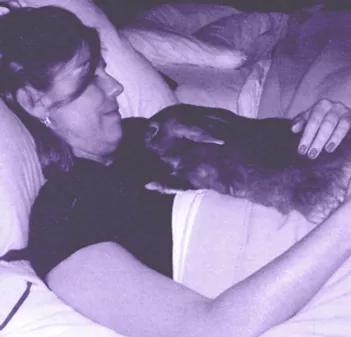
How a pet store bunny helped save my life
- By Nancy Laracy
By a stroke of fate or perhaps luck, after suffering for years from a connective tissue disease and fibromyalgia, I stumbled upon the most effective alternative treatment for my chronic pain: a nine-pound, cuddly red satin rabbit. In the middle of a blizzard, I rebelliously adopted the world’s unluckiest, luckiest rabbit.
Unlucky - because he was born with similar autoimmune disease as me.
Lucky - because we found each other.
And so began the magical story of Bunny Boy, our story of a lifelong bond formed in sickness and health.
Hurtling through life full throttle, as a mother of two children and a successful human resources executive in New Jersey, I was stopped in my tracks when I contracted an acute case of parvovirus B19. My life became all about pain when I developed a connective tissue disease and fibromyalgia as a result. I tried every mainstream and holistic treatment for my debilitating pain & fatigue, including acupuncture, chiropractic, massage, dry needling, and sleeping on a magnetic mattress, with little success. Then I met Bunny Boy.
When my children and I got cabin fever during a snowstorm and headed out to the pet store to buy crickets for our lizard during the Armageddon blizzard of 2001, despite the frigid weather, something in me began to melt when the owner of our local pet store placed a red satin bunny in my arms. Unable to have a dog or cat because my husband was allergic, for some reason, the idea of a bunny never crossed my mind until that night. It was as if, somehow, I sensed all that the bunny and I would come to mean to each other in the years ahead as the baby rabbit melted into my sweater.
At only nine months old, Bunny Boy was diagnosed with an incurable jaw abscess. We were told he wouldn’t live more than a few months. Well, that wasn’t good enough. I went into the same fighter mode for him that I used for myself, and Bunny Boy had surgery on his jaw, despite the fact that bunnies are prey animals with weak hearts. Anesthesia, fear, and post operative pain pose a much greater risk for a rabbit than other mammals. Quite simply, bunnies give up easily. But not Bunny Boy. He thrived postoperatively and continued to be a cherished member of our family, becoming the children’s mascots for their sports teams and the subject of their science fair. He traveled with me everywhere in the car and filled the void I felt over not being able to have more children due to my poor health.
When Bunny Boy’s abscess returned a few years later, our local veterinarian Dr. Cheryl Welch who had performed his first surgery sent us into Manhattan to the world famous Animal Medical Center, where they were experimenting with antibiotic beads for these types of abscesses. Bunny Boy pioneered the use of antibiotic beads that were placed in his jawbone and thrived yet again despite the odds, even though the infection had now also settled in his hocks. At a time when my children were growing up, our family bonded over Bunny Boy while we bandaged his paws and administered penicillin injections. When Bunny Boy went into cardiac arrest from a routine penicillin injection, my visiting brother (who ran a surgical wing at Estes Park Hospital in Colorado) started rescue breathing while my husband did the chest compressions. On the fifth rescue breath, Bunny Boy started breathing again. He helped teach the veterinarian community that even bunnies, the frailest creatures, can overcome medical ailments when they are loved deeply and cared for with kid gloves.
With colorful bandages on his thumper paws, Bunny Boy still gamboled around the house with a zest for life that was both amazing and inspiring. My furry little bunny taught me to put my own pain in perspective. Bunny Boy helped me to not feel so broken and showed me that it was okay not to be able to do everything I used to. When I underwent intravenous infusions of gamma globulin, he was there, tucked under my arm, as I endured muscle pain and fevers. I needed Bunny Boy as much as he needed me.
Several years later after Bunny Boy’s miraculous surgery, I developed an abscess in my bone stemming from the root of my tooth, much like Bunny Boy had. Initially, we were told it might be cancer. The surgeon implanted similar antibiotic beads that Bunny Boy had pioneered earlier, which went on to treat and remove the abscess. At the time I was on Enbrel, a powerful immunosuppressant, and without the beads the outcome could have been different.
For those of us suffering with chronic pain, getting a pet can sound like a lot of extra work and energy that we just don’t have. Bunny Boy taught me was that you are actually on the receiving end of pet therapy. Pets make us move—when we need to let them out or take them for a walk or, in my case, chase them around the house like a NASCAR driver that Bunny Boy clearly thought he was! They make us stretch to clean their litter pan, brush their silky fur, or snuggle. They stand at out feet and wiggle their little noses to be picked up or they binky across the carpet looking to play, which requires exercise on our part. What better therapy for fibromyalgia? Pets also teach us the importance of love and affection; and that really does heal, where medical science fails, and prolongs and improves the quality of our lives.
Bunny Boy meant so much to our family that I thought he might be inspiration for other people who were in pain. Soon, he became my informal therapy bunny, delighting dozens of patients at the rehabilitation center where my aging mother spent eight weeks. Tears rolled down my cheeks when a patient with Alzheimer’s who had not spoken in months strung together four words, “I pet the bunny,” as I placed Bunny Boy on his lap.
Bunny Boy and I became inseparable as we helped each other manage the chronic pain of autoimmune disease. We were the answer to each other’s prayers. He was the breath of fresh air that blew into my life, unknowingly, changing our family forever. Bunny Boy more than earned his nickname “Iron Bunny” among the veterinarian community and went on to live almost nine years. He died peacefully in my arms of old age.
Bunny Boy was, in the end, my role model for how to conduct oneself with dignity when life threw you one humiliating or difficult curveball after another. He suffered more indignities than any rabbit should have, but his joie de vivre taught everyone who crossed his bunny trail a thing or two about how to live life to its fullest.
After grieving appropriately for Bunny Boy, I adopted another house rabbit, a jersey woolie named Muffin.
We became the first certified bunny therapy team on the east coast of the United States. I planned and implemented bunny therapy programs for the sick children. I used educational books, narrated by Bunnies that helped children deal with feelings of sadness, fear, anger and all of the feelings they experience having cancer or some other life threatening disease. I autographed them all from Muffin, having her own stamp paw print made, and donated hundreds of stuffed bunnies and bunny crafts, tailored for each event theme.
Various vendors donated chocolate bunny lollipops, bunny cupcakes and more!
The programs grew in size and scope over the seven years as a branch of BIB until sadly Muffin died sadly of congestive heart failure at seven years old. She had huge paw prints to fill after Bunny Boy and she proudly did just that in her own right.



